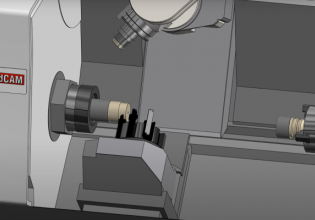Understanding Temperature Sensors and Their Use in Industrial Automation
Converting thermal energy into electrical signals, temperature sensors such as RTDs and thermocouples are fundamental in the maintenance and operation of industrial environments and equipment.
See Our Previous Articles on Industrial Sensors:
- Introduction to Industrial Sensors
- The Basics of Optical Sensors and Common Types
- Lasers and Their Uses in Sensing and Object Detecting
- The Power of Invisibility: Infrared Sensors for Automation
Measuring temperature is a centuries-old practice that still today is fundamental in industrial automation. Assessing the intensity of heat has been a challenge since prehistoric times, but it was not until the Renaissance that the first major steps forward were taken. From the first observations of heat-induced expansion by Galileo in the sixteenth century through the invention of the first liquid-based thermometer in 1612 and the creation of the units of measure, this age was crucial for the advancement of thermodynamics.
Another important breakthrough was the discovery of the relationship between temperature and electricity. In 1821, German physicist Thomas Seebeck discovered the electric properties of bimetallic assemblies, also known as thermocouples. He realized that a voltage difference was produced when heating two metal parts with different properties.
The discovery of thermal radiation was another crucial moment. Scientists found ways to assess the infrared light produced by bodies emitting heat.

Figure 1. Infrared thermometer measuring thermal radiation. Image used courtesy of Adobe Stock
These scientific discoveries have created the basis for developing modern temperature sensors, many of which are high-technology and can be integrated into automated systems. In the next sections, we will review the physics behind temperature measurement and some of the most common types of temperature sensors.
How Is Temperature Measured?
Temperature sensors convert thermal energy into electrical signals. For this to happen, thermal energy is first transferred from the sensed object to the sensor, which can occur through direct contact or radiation. In either case, heat transfer is required.
After the transfer of energy, there are two ways in which the sensor can convert the electric signal. One of them is called equilibrium. Under equilibrium, the signal conversion begins once the temperature difference between the sensor and the surface is minimal. That difference is also called a thermal gradient. Most contact sensors work in this way.
Predictive-based thermal sensors determine an object's temperature by measuring the temperature change rate. This method is useful in applications where measuring is slow.
Resistance Temperature Detector (RTD)
Most commonly known by their initials, RTD, these sensors employ the concept of electrical resistance dependent upon temperature changes. By far, the most common metal used for this application is platinum due to its durability and stability.
Platinum RTDs can be fabricated in two ways: thin-film and wire-wound. The thin-film configuration uses a very thin platinum wire coated with silicon. On the other hand, the wire-wound RTD consists of platinum winding inside a ceramic tube.
There are also different wiring configurations: 2-wire, 3-wire, and 4-wire. The 2-wire sensor is the simplest configuration, employing single wires connected at each end of the sensing element. Although simple, these sensors can produce errors, with readings higher than the actual temperature.

Figure 2. 2-wire, 3-wire, and 4-wire RTD configurations. Image used courtesy of Tekon Electronics
The 3-wire connection is the most popular in the industry. It reduces errors by placing an additional wire, as shown in the picture above, removing the resistance of the measurement cable. The 4-wire configuration provides maximum accuracy by employing two pairs of wires, one for carrying the current and the other for measuring resistivity.
Thermistor Sensor
The word thermistor is a contraction of the words thermal and resistor. These sensors use semiconductor materials and behave similarly to RTDs, measuring electrical resistivity. However, building materials such as metallic oxides and ceramics provide greater operating ranges than RTDs.
There are two main types of thermistors: Negative Temperature Coefficient (NTC) and Positive Temperature Coefficient (PTC).
NTC thermistors are the most popular. In this configuration, the resistance value decreases with the increase in temperature. However, the relationship between the two quantities is non-linear. Therefore, NTC thermistors must be calibrated for the specific application to produce accurate results.
PTC thermistors are more commonly used for circuit protection. These sensors make the electrical resistance highly sensitive to temperature changes, producing accurate results and larger operating ranges.

Figure 3. NTC thermistors are compact in size. Image used courtesy of Epcos
Thermocouple
Thermocouples are another sensor variant that utilizes the dependencies between temperature and resistance. In this configuration, two dissimilar metal wires are connected at one end and to a thermocouple-capable device at the other. The metal wires produce a temperature-dependent voltage input to the device, such as a multimeter.

Figure 4. A multimeter and thermocouple combination. Image used courtesy of Klein Tools
The scientific principle behind these sensors is the Seebeck effect, which studied the voltage differentials between two dissimilar metals upon temperature changes.
Varying thermocouple material combinations produce different voltages at certain temperatures, leading to variety of ‘types’ that areacceptable for use at different temperature ranges. Each thermocouple type must be matched with a proper transducer that converts a small voltage to an equivalent temperature for that unique material combination.
Infrared Thermometer
These contactless temperature sensors can read the infrared radiation emitted by sensed objects. Infrared sensors absorb some of the radiation and convert it into an electrical signal. For more details on infrared thermometers, please refer to the previous article on infrared sensors.
Industrial Sensors
In the next article in our series, we will take a closer look at magnetic and inductive sensors and the types used in industrial automation.





